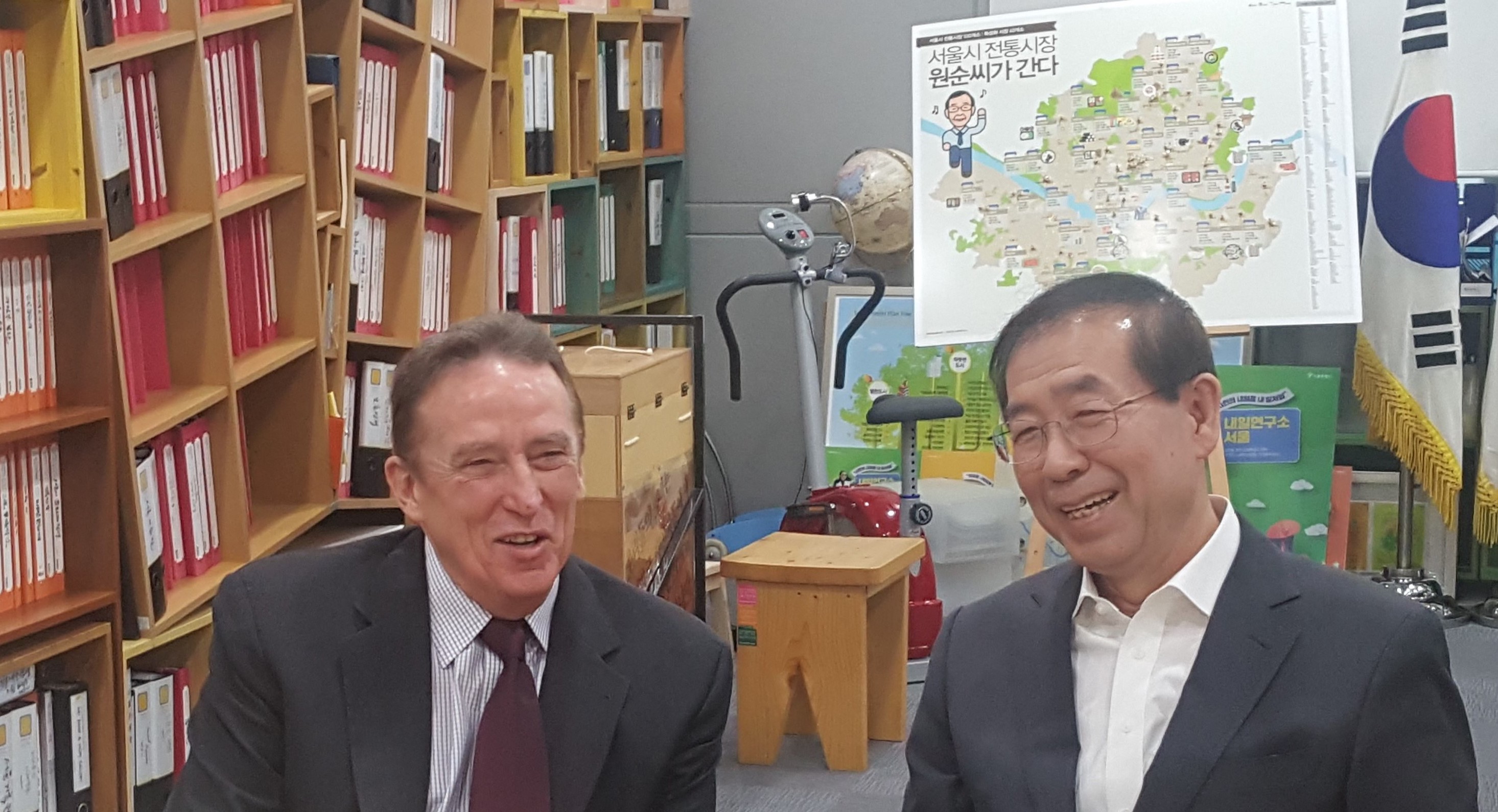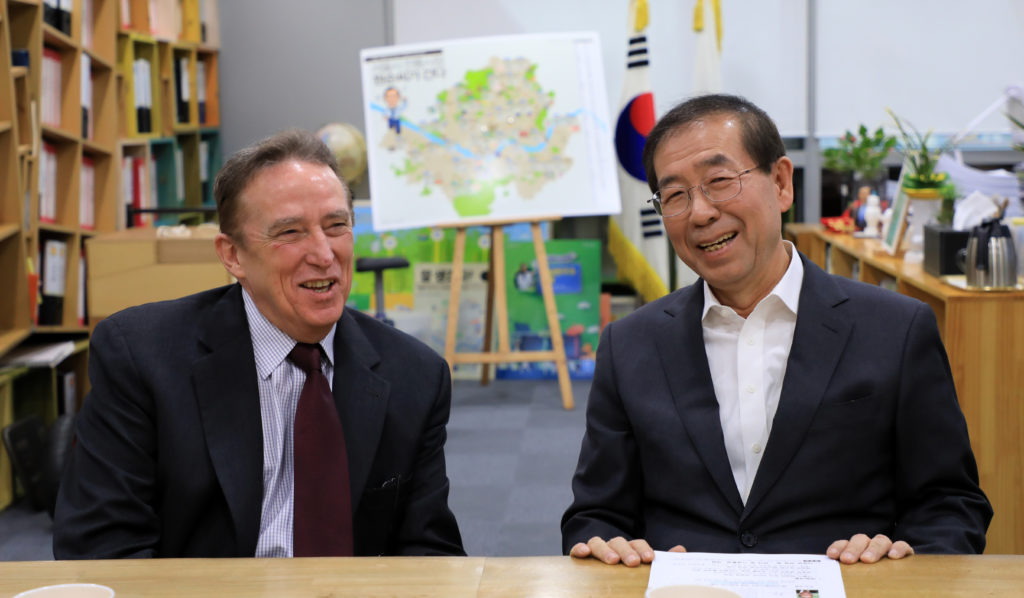
The government of Seoul has announced plans to invest $1.5 billion in a new initiative that aims to deploy 1GWp of solar energy by 2022.
In November 2017, Seoul Metropolitan Government (SMG) declared its intention to deploy 1 gigawatt of rooftop solar as part of its “Solar City Seoul” master plan. Over the next five years, Seoul city government plans to invest $1.5 billion to make the project a reality. This is a significant step forward in the future of Seoul’s sustainability contribution and follows in the wake of the very successful first stages of the city’s One Less Nuclear Power Plant (OLNPP) initiative. 1 Under initiatives like the OLNPP, Seoul focused heavily on promoting energy conservation and efficiency improvement. With this new Solar City Seoul plan, the city is ramping up investment in energy production as well. FREE applauds this direction chartered by the Mayor of Seoul, Mr. Park Won-soon.
FREE has been actively advising the city for five years on the prospects of becoming a “solar city.” As part of the Seoul International Energy Advisory Council (SIEAC), Dr. John Byrne has described to city officials the potential of rooftop solar across the 10-million people strong city. FREE has also published several refereed articles analyzing the emergent role of the solar city concept coupled with new priorities, such as policy effectiveness, solar financing support, and market mechanisms available to Seoul to explore this potential in detail. 2 For example, research we have conducted shows Seoul has a full deployment potential of about 10 gigawatts. 3
FREE attended the launch of the initiative. Mayor Park Won-soon and Dr. Byrne were interviewed by leading Korean newspapers on the strategy. During an interview with Kyunghyang Shinmun, Mayor Park underscored FREE’s role, noting that he “had an opportunity to take a view of the downtown area in Seoul from Namsan Mountain with Prof. Byrne. As I talked with him, I realized that Seoul has a significant PV technical potential.” 4

A striking feature of the Solar City Seoul plan is the commitment to increase household-level PV deployment through miniature solar generators installed on rooftops and verandas or so-called “mini-PV” technology. This prong of the plan will engage more than 100,000 households in helping to supply solar energy to the city! This is exactly in tune with the Mayor’s original pursuit of the idea that “citizens are energy.” The initiative will make solar energy a part of the everyday life of Seoul’s citizens and businesses.
FREE has worked extensively on the concept of the “solar city” – the citywide deployment of rooftop solar energy. Our work shows not only that Seoul has significant potential to develop itself as a solar city but that cities like New York, Tokyo, London, Amsterdam, and Munich possess similar resources. 5 Indeed, a paper published in the International Journal of Urban Sciences by the FREE research team highlights the fact that this opportunity is common to most cities around the world. 6 An investigation of the market, finance, and policy considerations associated with solar city deployment found that the concept is not only technically feasible but it also creates practical economic benefits, including job creation and expansion of local green industries, and results in significant environmental benefits by shrinking the city’s carbon footprint by more than 10 percent. 7
“I will make Seoul a place where PV can be found everywhere”, the Mayor said. The FREE team will be there to continue to help make this ambition become unavoidable reality.
- FREE published a blog article on the OLNPP initiative which can be accessed at: https://freefutures.org/one-less-nuclear-power-plant-seouls-commitment-to-a-low-carbon-and-non-nuclear-city/
- For more information on our publications, please see freefutures.org/publications
- Byrne, J., Taminiau, J., Kurdgelashvili, L., & Kim, K. N. (2015). A review of the solar city concept and methods to assess rooftop solar electric potential, with an illustrative application to the city of Seoul. Renewable and Sustainable Energy Reviews, 41, 830-844. doi://dx.doi.org/10.1016/j.rser.2014.08.023
- Translated from the Korean newspaper Kyunghyang (article, in Korean, can be found at: https://news.khan.co.kr/kh_news/khan_art_view.html?artid=201712072105005&code=100100
- Byrne, J., Taminiau, J., Kim, K. N., Seo, J., & Lee, J. (2016). A solar city strategy applied to six municipalities: Integrating market, finance, and policy factors for infrastructure-scale photovoltaic development in Amsterdam, London, Munich, New York, Seoul, and Tokyo. Wiley Interdisciplinary Reviews: Energy and Environment, 5(1), 68-88. doi:10.1002/wene.182
- Byrne, J., Taminiau, J., Seo, J., Lee, J., & Shin, S. (2017). Are solar cities feasible? A review of current research. International Journal of Urban Sciences, 1-18. doi:10.1080/12265934.2017.1331750
- Byrne, J., Taminiau, J., Kim, K. N., Lee, J., & Seo, J. (2017). Multivariate analysis of solar city economics: Impact of energy prices, policy, finance, and cost on urban photovoltaic power plant implementation. Wiley Interdisciplinary Reviews: Energy and Environment, , n/a. doi:10.1002/wene.241
 FREE launched a new 3-point strategy after the United Nations Climate Conference in December 2015 in Paris. FREE is focusing on further development of ‘solar cities’ and ‘sustainable energy financing’ in the context of ‘polycentric’ climate change governance.
FREE launched a new 3-point strategy after the United Nations Climate Conference in December 2015 in Paris. FREE is focusing on further development of ‘solar cities’ and ‘sustainable energy financing’ in the context of ‘polycentric’ climate change governance.